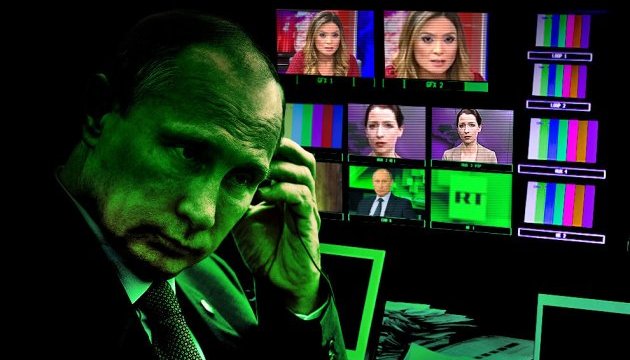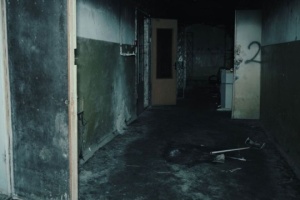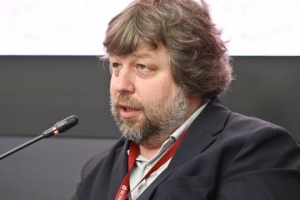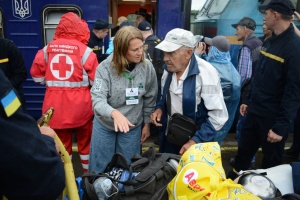
Shelling of civilians in Eastern Ukraine as Putin’s grand fake
Since November 27, Russian propaganda has been airing stories involving “shelling” and “suffering of civilians” in Donetsk almost every day.
Since early December, Russians have been dramatically pitting locals against Ukraine, provoking yet another wave of enmity. At the same time, Kremlin propaganda portrays the shelling of Donetsk as “unprecedented” and “largest since 2014.” This mirrors the narrative of terror being committed against Ukrainian civilians. On December 15, in addition to the usual shelling of civilians, propaganda also covered damage to the Savior-Transfiguration Cathedral in Donetsk.
A lot has already been said about Kyiv never being interested in pitting civilians in Donbas against itself. But it’s understood why Moscow needs this. On December 7, at a meeting with members of the “Human Rights Council,” Putin admitted with a smile on his face that for Russia, the capture of Ukraine’s lands is a serious result: “Well, this is still a significant result for Russia. This is a serious question. Truth be told, the Sea of Azov has become Russia’s inland sea. Peter the Great was fighting to advance to the Sea of Azov.”
But before annexing the territory, it was necessary to deceive many people: to convince them that Ukraine is their enemy, and therefore Russia is fighting for them, not for territories.
At that meeting, Putin also mentioned his “grand fake” narrative: “Strikes are delivered directly on residential areas. No one can but know about it. Everyone is silent. Like nothing is happening. It’s horrible, of course… There can be only one answer on our part — a consistent fight for our national interests. We’re going to do precisely that.”
The picture of the killing of civilians becomes the main “firewood,” thanks to which Putinism manages to incite war at an emotional level. The Kremlin’s manipulation on human grief is all the more cynical because it is impossible to hide casualties that the Russian army brings by attacking residential areas of Ukrainian cities.
And no matter how artificial all this may look, on some Ukrainians and oblivious audiences (for example, Russians or residents of distant countries), the narrative claiming that “Ukraine bombs Donbas” can indeed make an impression.
We can recall how in 2008 many Ukrainians became victims of a similar information campaign by the Kremlin, claiming that Georgia attacked South Ossetia and “killed 2,000 civilians.” For example, on August 9, Russian Ambassador to Georgia Vyacheslav Kovalenko said that at least 2,000 civilians had been killed. Although these claims were later convincingly refuted, at the time of the claim they partially achieved the expected emotional effect, even in Ukraine.
“Donbas had been bombed for eight years” became a similar “justification” for attacking Ukraine. And it works for Russians who are unable to acknowledge the criminal nature of their own state — because then the picture of their world would collapse. Even the imaginary “parity” of innocent victims of war serves as a lifesaver for their conscience.
In fact, there any “parity” is off the table. The civilian death toll in 2014-2021 (on both sides of the contact line) is simply incomparable with the losses that Ukraine suffered after the start of the full-scale invasion.
A report by the Office of the United Nations High Commissioner for Human Rights (OHCHR) indicates that the number of civilian casualties has drastically decreased by 2022.
The narrative of violence against civilians in eastern Ukraine is also widely spun by Russian propaganda abroad. For example, RT shoots documentaries for foreign audiences in different languages, “exposing” Ukraine as a murderer of civilians. And millions of people who come across dramatic footage of the deaths of children and adults on the Internet believe in the “atrocities committed by Ukraine” and will continue to perceive the Russo-Ukrainian war accordingly. These are Orwellian lies in action.
This is how “war correspondent” Yevgeny Linin explained the moods in Donetsk on Russian television around December 10. “Donetsk may lose its patience. Those guys from defense, those who are on the line — they are ready to go to the very end — to the border with Poland. And if there is an order, then even farther. Strategically, different directions are now being played out. We see how the situation is unfolding in Kherson, Zaporizhia regions… Here, Donetsk turns out to be a bastion, against which everyone breaks their spears.”
However, as the ancient Roman principle proclaims, “Seek who benefits.” For example, after the beginning of the full-scale invasion, Russians mobilize fooled Ukrainians to fight Ukraine. And in 2014, the Kremlin sought to mentally detach Donbas from Ukraine, provoking a bloody feud with long martyrology of victims on both sides.
In the campaign of recent weeks, there has been a noticeable attempt by Russians to influence exactly the inhabitants of the former temporarily occupied territories of Luhansk and Donetsk regions. Perhaps these efforts are aimed at additional recruitment of militants and increasing their motivation for future offensive action.
At the end of 2016, the former leader of the so-called “LPR” Valery Bolotov said in an interview that the shelling of Luhansk was carried out by fighters from the Zarya Battalion.
This confession was made in response to a question by Rosbalt: “It is known that Igor Plotnitsky commanded the Zarya Battalion, there are rumors in Luhansk that it was this battalion that staged provocations and shelled Luhansk in the summer of 2014. Is this true?”
“Yes. And not only Zarya. Many people were deployed here to carry out sabotage and undermine discipline. And Zarya turned out to have the highest share of those ‘saboteurs.’”
Two months after this interview, Bolotov suddenly died after having a cup of coffee at a “business meeting” in Moscow. His widow pointed to poisoning as a possible cause of the militant’s death. That confession of his could be the reason behind his assassination.
In 2018, Denys Kazanskyi shared another video, in which another “LPR” militant from Russia, Alexander Lis (Agafonov), confessed that in 2014, Plotnitsky had shelled Luhansk on purpose.
Rumors about “nomadic mortars” shelling the city spread among Luhansk residents since the very beginning of conflict. At the same time, Luhansk journalists were surprised by the fact that Russian propagandists were at the scene of the tragedy even earlier than local media. There is also direct evidence that the shelling was carried out from Russian positions. For example, during a phone conversation, a person heard a missile flying from a Russian position near the city and exploding in Luhansk, which the second interlocutor then heard.
After the start of the full-scale war, in August, Russian propaganda was promoting a similar topic, claiming Ukraine insidiously launched at Donetsk Lepestok anti-personnel mines. Mines were scattered around the city, and people would lose their lims if they were to step on one. As proof of this, propaganda broadcast stories involving the injured locals.
However, there are no Lepestok mines in Ukraine’s arsenal, since they have been destroyed in accordance with the Geneva Convention prohibiting the use of anti-personnel landmines.
And here is how the regular propagandist of the Kremlin regime, neo-Stalinist Starikov, pushes the topic of shelling, ultimately concluding that the war with Ukraine must be continued.
What goals do the Russians pursue by manipulating the opinion of Ukrainians in the temporarily occupied eastern regions? On June 1, volunteers of the international intelligence community InformNapalm released a document — an information campaign plan developed by the so-called “Ministry of Information of the DPR” on the instructions of Russian supervisors.
Among the goals, we see the following: “to reduce the level of social tension among the families of servicemen mobilized to participate in the special military operation; to form (continue the formation) a loyal attitude towards the servicemen of the allied forces participating in the special military operation among the residents of the DPR (including the residents of the liberated territories), and a negative attitude towards the Ukrainian army.”
As we can see, Russian propaganda in the occupied East of Ukraine must constantly solve the difficult task of fooling people and explaining why they actually need to fight. This requires a constant feed of atrocities brought by provocative acts of terror.
Another document, which was published by InformNapalm volunteers, features the “Ministry’s” report on the results of information sabotage in 2021.
According to the document, this activity was based “on carrying out information sabotage that creates a negative image of the Armed Forces of Ukraine and the military-political leadership of Ukraine, affecting the morale and mental condition of Ukrainian servicemen, misleading the Ukrainian command (through disinformation), provoking multiple official investigations within law enforcement agencies of Ukraine, etc. THroughout the year, 53 acts of information sabotage were carried out (listed in chronological order).”
Among other things, item No. 49 of the document says that “a staged video was filmed about Ukrainian soldiers using a 120 mm mortar to fire at Donetsk. The video was published on the previously hacked website of the Ministry of Defense of Ukraine (over 100,000 views).” No. 13 says that “disinformation has been published on the preparation of a provocation by the AFU on their territory involving deaths of local residents to create grounds for a full-scale offensive (over 500,000 views).”
“Crime and Punishment”
Evidently, Russians had quite a workshop creating fake videos. However, great historical achievements, as the bloody scriptwriters of the Kremlin believe, take real tragedies with real dead people because this allows you to control people’s emotions.
Let us recall that Putin’s ascension to the Russian political Olympus was accompanied by explosions of residential buildings in Buynaksk, Moscow, and Volgodonsk, which played the role of casus belli for the revanchist second Russian-Chechen war. In his book The FSB Undermines Russia, Alexander Litvinenko, who was later killed by agents of the Kremlin, blamed his former employers for these acts of terror. During the planting of explosives in Ryazan, a group of FSB officers was actually detained, and later, after confusing excuses, the Russian authorities declared this case an exercise. It seems that terrorist attacks and provocations to incite war lie in the very essence of Putinism.
The methods of sabotage tested in the Caucasus are now being employed against Ukraine. Monitoring of 19 German media outlets in November, conducted by Vox Ukraine, identified 155 cases of disinformation. Most of them (47) were about the Ukrainian army allegedly committing war crimes. Representatives of Ukrainian authorities were discredited in 14 cases. 13 cases were about “Nazism in Ukraine.”
Researchers from Vox Ukraine write: most often, the propaganda media in Germany mention “war crimes of Ukraine” precisely in the context of shelling of the temporarily occupied territories of Ukraine. For example, shelling of the occupied Donetsk oblast, during which civilians are killed, for which only the Ukrainian military is blamed. The Armed Forces of Ukraine are also named as the main culprits for the shelling of crossings for civilians in the Kherson oblast, which prevents civilians from safely evacuating from the war zone. Inhumane conditions, torture in captivity, lynchings of collaborators — all these crimes are also attributed to Ukrainian soldiers.”
Various information about Russian provocations, in particular, testimonies of eyewitnesses, victims and perpetrators, needs systematization and generalization. This would help consolidate all the separate cases into a single proceeding in the investigation of Russian war criminals.
The victims of such terrorist attacks are not those killed, maimed, and deprived of their property. Millions of people who are deceived and charged with hatred suffer from this, too. The very chance for a future peaceful coexistence of those affected by this war in Ukraine is deliberately targeted by the enemy.
Center for Strategic Communication and Information Security




